|
Special Features





Image Libraries


|
|
Blog
A number of libertarian blogs have picked up BeyondDC’s post showing before and after aerials of Southwest urban renewal and citing it as an example of why government city planning is inherently bad.
That’s a little like saying contemporary doctors are bad because once, long ago, tribal medicine men practiced voodoo and it didn’t work. Or it’s like saying international travel by contemporary airplane is impossible because the Wright brothers’ first plane only managed to fly a few yards. Simply put: Citing an obsolete example of something doesn’t make the contemporary version wrong.
There are lots of things wrong with contemporary planning (*cough* zoning), but the fact that planners made mistakes a half century ago isn’t one of them.
Average Rating: 4.4 out of 5 based on 288 user reviews.
January 31st, 2011 | Permalink
Tags: government, master planning

Last year during snowpocalypse I observed that while most suburbanites spent the post-storm days stuck at home waiting for plows to clear their roads, many urbanites treated the days off like a big community party, and moved about their neighborhoods at will.
This year’s storm offers an even more dramatic illustration: Last night’s commute.
It was undeniably rough for urbanites. Metro was slow, buses got stuck and then stopped running, and anyone who walked more than a block got wet and cold. My experience, and the experience of most of the people I’ve talked to, is that in the city last night’s commute took about twice as long as usual.
But “rough” isn’t the same as “nightmare”, which is the only way to describe what travel in the suburbs was like last night. My father works in Merrifield and lives in Chantilly, and it took him 8 hours to drive home; he left at 5:30 and didn’t get home until at least 1:30. A friend who’s a planner in Fairfax and lives in Centreville was in his car for 7 hours. Another friend who lives in upper Montgomery County left his office at 4:45 and didn’t get home until 1:00 am. And that’s just three of my own friends who have mentioned it on social media. It got much worse for others.
To be fair, there are some 5 hour horror stories from transit too, but much fewer and further between than the driving stories. It just never got that bad in the city. When you have a full grid of streets, it doesn’t make much difference if one becomes impassible. When you have a plenitude of multi-modal travel options, it doesn’t make much difference if any one shuts down for a while. On the other hand, when your only option is to drive on one single particular road, good luck when that one particular road gets blocked.
So what do we take from all this? I said last year that one shouldn’t base life decisions on the possibility of a freak event, and that’s still true, but at the very least this is another thing to consider when you’re making that choice, and another reason to make sure more people have the choice available to them.
Average Rating: 4.7 out of 5 based on 234 user reviews.
January 27th, 2011 | Permalink
Tags: roads/cars, transportation

It’s the tail end of January and the weather is cold and nasty. We’ve officially reached the depths of winter. To make you feel better, here’s a nice warm-looking picture of Waikiki, Honolulu, courtesy flickr user jayul:
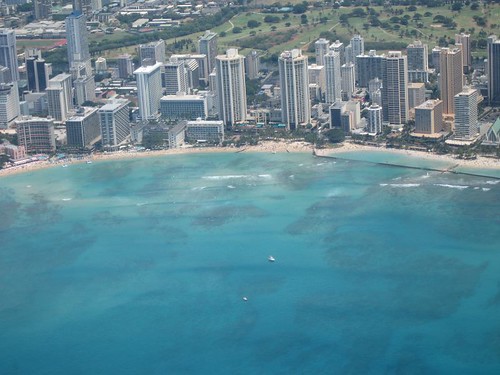
Isn’t that nice.
Average Rating: 4.9 out of 5 based on 233 user reviews.
January 26th, 2011 | Permalink
Tags: fun, galleries

Arlington’s CommuterPageBlog has this awesome map showing Capital Bikeshare usage over time. The darker the line, the more trips are made between the two stations that line connects.
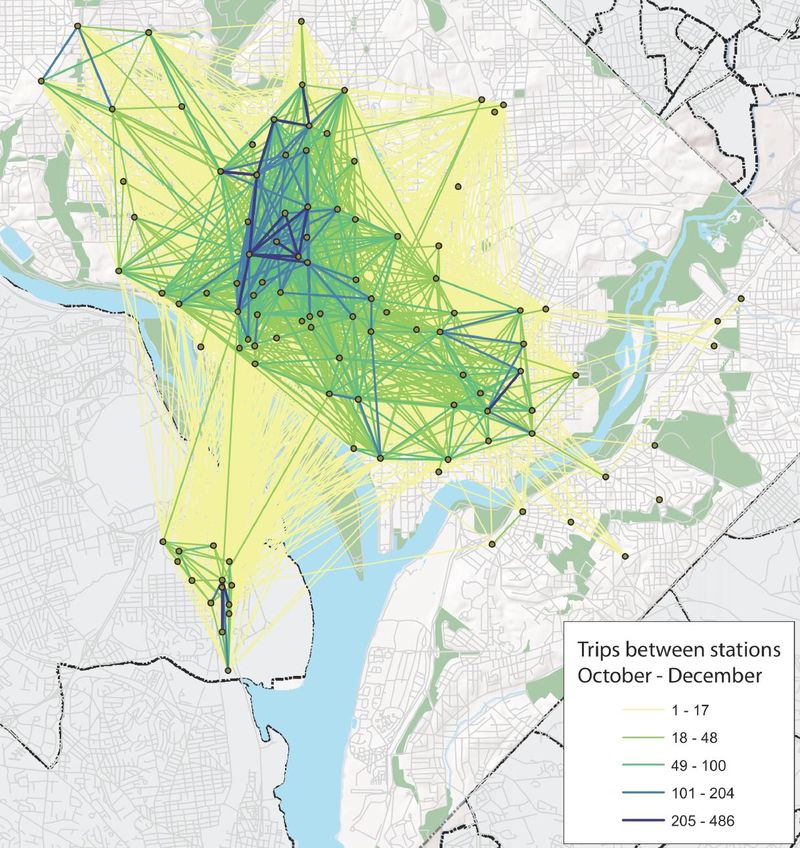
The densest concentration of users appears to be a triangle with points at Logan Circle, Dupont Circle, and the Reeves Center at U Street. It will be interesting to see how this changes over time as service is expanded to more neighborhoods.
Average Rating: 4.6 out of 5 based on 167 user reviews.
January 24th, 2011 | Permalink
Tags: bike, transportation, urbandesign

The comments from my last post are interesting. They seem to fall into a couple of categories: 1) People who think it was smug for me to point out that I don’t have to sit through the same hell they do, and 2) people who feel it’s important to point out that not everyone has the choice available to them, because the city is expensive and/or a lot of jobs are located in the suburbs.
I don’t put much stock in the first comment. I will not apologize for opting out of a miserable experience, nor for suggesting that opting out is possible. The second comment on the other hand is much more fair, and I think it merits some further discussion.
It’s true that not everyone who would like to live a traffic-free urban lifestyle can freely choose to do so. This is because we don’t have nearly enough urban supply to meet the demand, and because our transportation system is skewed heavily to an auto-oriented extreme that makes driving easier the only practical option in all but 6 or 7 cities around the country.
The real lesson, therefore, isn’t so much that some people are capable of opting out of the system (and though it isn’t available to everyone, the choice is certainly available to many people who don’t take it). Rather, the lesson is that we need to stop dictating that most people live in suburbia via bogus land use regulations and transportation subsidies that force most development in that direction.
One commenter opened his comment by asking “Why is it that affluent city dwellers demand that everyone adopt their chosen lifestyle?” He later backed off the statement, but I think it’s a particularly ironic question, because the fact that so many people want to live in the city but can’t is a very strong indication that reality is the other way around. If the market weren’t so restricted, urban developers would be able to meet the demand for urban living. If the supply weren’t so much smaller than the demand, more people would be able to choose to opt out traffic, which would benefit everyone (including those remaining on the highways).
Not to put all the blame on nefarious suburbanites. The city needs to improve itself too, especially the schools.
Ultimately the best comment in the thread came from someone named Steve, who summed things up thus: “The response to this annual story from the Post about the UMR should be that more people should be given the opportunity to opt out of traffic.”
Indeed.
Average Rating: 5 out of 5 based on 261 user reviews.
January 21st, 2011 | Permalink
Tags: government, land use, law, roads/cars, transportation

|
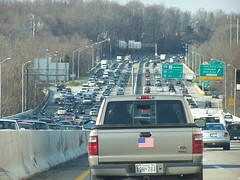
Opting out of this misery is easy. |
Apparently the suburban hinterlands of DC have bad traffic congestion. That’s a bummer.
I say “apparently” because I virtually never experience any of it first hand, since I’ve opted out of the lifestyle that requires people to sit in traffic. Living in the city it’s easier to get around by walking, transit, cycling, and the occasional taxicab than by driving, so traffic congestion is simply not something I ever have to think about. I can remember exactly one traffic jam that I’ve been part of over the last year, and it happened while visiting my family in western Fairfax County.
Traffic jams are a choice. People choose to subject themselves to them based on where they choose to live and how they choose to get around. For me, opting out was an easy decision.
Average Rating: 4.8 out of 5 based on 244 user reviews.
January 20th, 2011 | Permalink
Tags: roads/cars, transportation

|
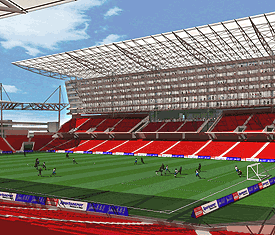
Old proposal for a Poplar Point stadium. |
DCist reports that DC United is considering four sites in the city for a potential soccer stadium, and that one of the sites is a couple of blocks from the Nationals baseball stadium on South Capitol Street. DCist says:
The idea of a sporting complex featuring a United stadium near the Nationals’ home field is certainly something which makes some sense, mimicking other cities who have a similar arrangement like Philadelphia, Pittsburgh and Baltimore.
Other cities may do it, but it’s a bad idea. While the prospect of an in-town soccer stadium certainly has potential, it would be a mistake to locate it in the same neighborhood as the baseball stadium, or any other large sports facility. Stadiums take up a lot of land, and while they generate periodic large crowds, putting multiple stadiums in close proximity to each other reduces the mixed-use potential of their neighborhood. One stadium can be an anchor for diverse surrounding land uses, but multiple stadiums makes for a sports ghetto rather than a living neighborhood. Those sporting complexes in Philadelphia, Pittsburgh and Baltimore make some sense if you’re a suburbanite driving in, but none of them are urban neighborhoods approaching the quality of Gallery Place.
I’m all for using stadiums as a tool to bring people into the city, but people are already coming to the area around Nats Park. Rather than adding a redundant use to a neighborhood that won’t benefit from it, let’s put a stadium for United someplace where it will do good – someplace that needs the attention.
Average Rating: 4.5 out of 5 based on 186 user reviews.
January 19th, 2011 | Permalink
Tags: development

88% of the Millennial generation wants to live in an urban setting, according to a survey reported on by the Wall Street Journal.
That’s a staggering statistic, with equally staggering implications. There are 80 million Millennials in the United States, which means that even ignoring all other demographics there is an existing market of 70 million people who want to live the urban lifestyle in this country. 70 million! That’s more than the total population of France. It’s five times the combined population of the cities of New York, Chicago, San Francisco, Philadelphia, Boston, and Washington (generally considered to be the six most urban in the US).
It means there’s an absolutely tremendous unmet demand for urban living in this country, and that there’s an equally tremendous oversupply of suburban homes. It means that it is time to rethink how we define the American Dream.
Some naysayers may suggest this is a blip, that young people have always liked cities, but once they start having children they’ll abandon them for the ‘burbs just like their parents. I dispute that. I don’t intend on leaving my future children trapped in a house that’s only accessible by car, with nowhere to go and nothing to do except play video games and get high. But that’s beside the point. Even if the naysayers are right, there will still be a revolving door of scores of millions of Americans who want to live the urban life.
This is a big deal, no ifs ands or buts about it.
Average Rating: 4.5 out of 5 based on 283 user reviews.
January 14th, 2011 | Permalink
Tags: The New America

|
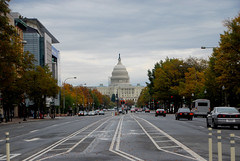
Should Pennsylvania Avenue be renamed? |
Now here is a ballsy idea, courtesy DC at-large council member Michael Brown:
The D.C. Council is considering a name change for the stretch of Pennsylvania Avenue between the 1300 and 1400 block. The change would reflect the city’s ongoing quest for statehood.
This is too hilarious to pass up. Reasonable compromise has failed us, so why not try the crazy approach? Let’s use what tools the city has at its disposal to draw attention to the shame on democracy that is DC’s lack of representation.
My only complaint is that we’re limiting the proposal to the 1300 block. If we really wanted to stick it to the feds we’d rename the whole stretch between the White House and Capitol, or at least the 1600 block (the White House is at 1600 Pennsylvania).
Here are some naming ideas:
- Taxation Without Representation Avenue
- Embarrassment To Democracy Avenue
- Partisanship Before Values Avenue
- Second Class Citizens Avenue
- 600, 000 Americans Who Don’t Count Avenue
Who can think of something better?
Average Rating: 4.6 out of 5 based on 191 user reviews.
January 13th, 2011 | Permalink
Tags: fun, government, proposal, roads/cars, transportation

|

Matt’s proposal for three-letter station codes. |
Matt Johnson has an interesting post up at Greater Greater Washington proposing three-letter abbreviations for Metro stations, in the tradition of airport codes. The idea is that instead of writing out “U Street/African-Amer Civil War Memorial/Cardozo”, you’d just go with “UST” and everyone would know what you meant. The post was in response to a suggestion that he and I consider such a code system, so I may as well share my thoughts too.
Matt and I talked about it a bit on Twitter and then went separate ways. He wanted to try three-letter codes and I wanted to try two-letter ones. I never got around to putting my codes onto a map, but they’re available in spreadsheet form. Like Matt, I developed some guidelines. They were:
- If the station name is two words, use the first letter of each word.
- If the station name is one word, use either the first and last letter, the first letters of each syllable, the first and second letter, or (in rare cases) the first letter plus a vowel or consonant that stands out for some reason.
- Focus on the common names for the stations, not the long official names.
- No duplication of codes. When duplicates appear, change both of them to avoid confusion (so no one wonders if CH is Court House, Columbia Heights, Congress Heights, or Capitol Heights).
Ultimately, that last ‘no duplication’ rule proved the biggest problem, and the biggest reason why I think Matt’s three-letter system is superior. It isn’t just that there are four CH stations. BR, CP, MC, and US all show up more than once, requiring more than ten stations to have non-intuitive codes. That just won’t do when there’s a perfectly good three-letter alternative available.
Having come around to Matt’s point of view on the number of letters, what about his specific proposals? I think most of them are spot on, but there are a handful I’d change, generally because I think they could be more intuitive with regards to which consonant sounds are dominant. For example: RVL for Rockville, GVR for Grosvenor, FSH for Friendship Heights, and GLN for Glenmont.
But really, nitpicks aside, I like it.
Average Rating: 4.8 out of 5 based on 204 user reviews.
January 12th, 2011 | Permalink
Tags: fun, metrorail, proposal, transportation

|
Media





Site
About BeyondDC
Archive 2003-06
Contact
Category Tags:
Partners
|



















